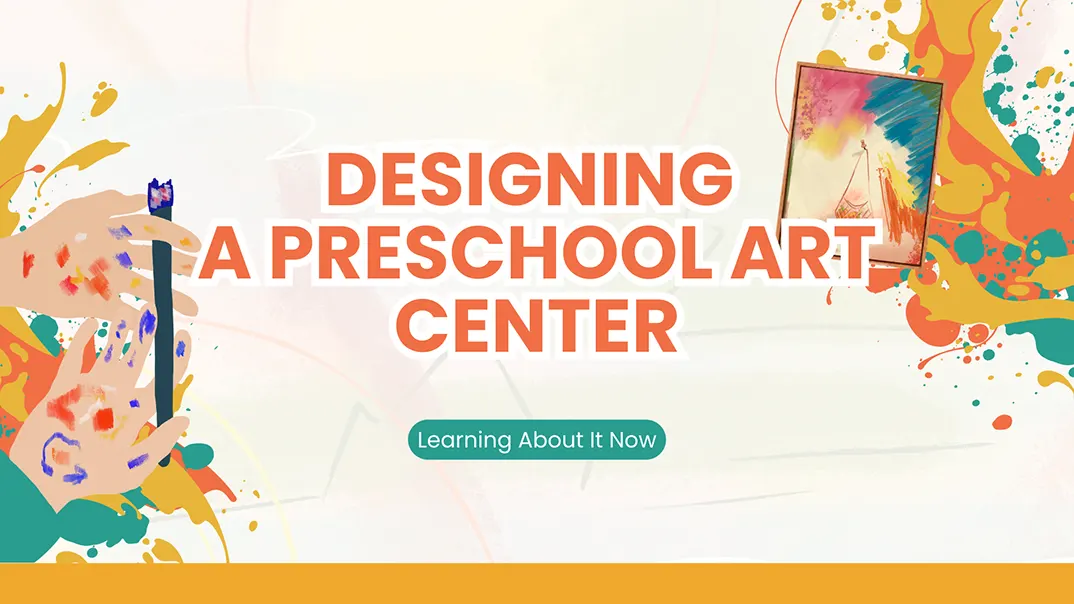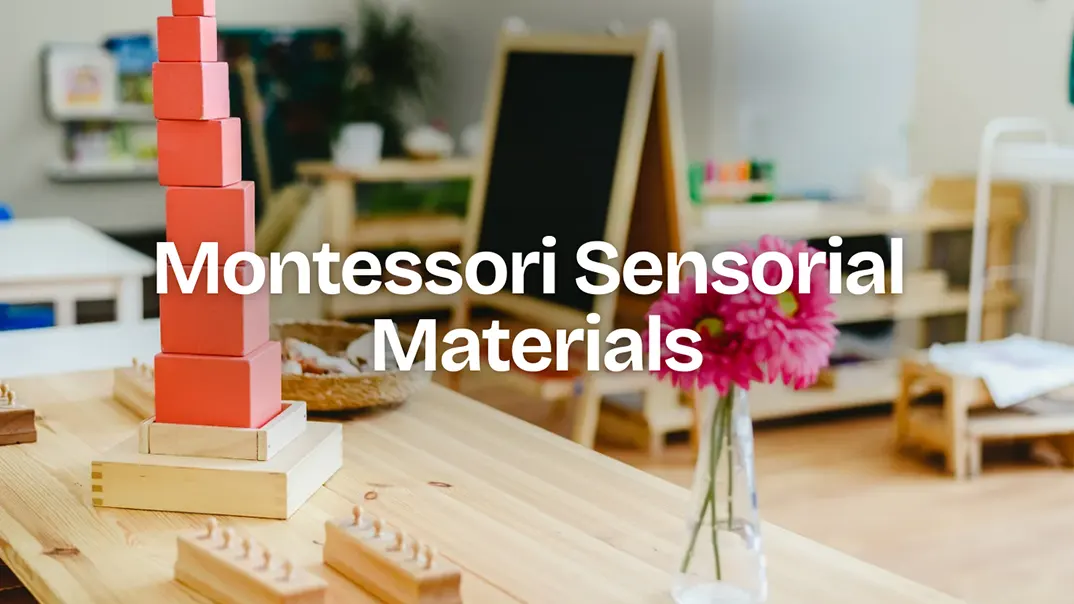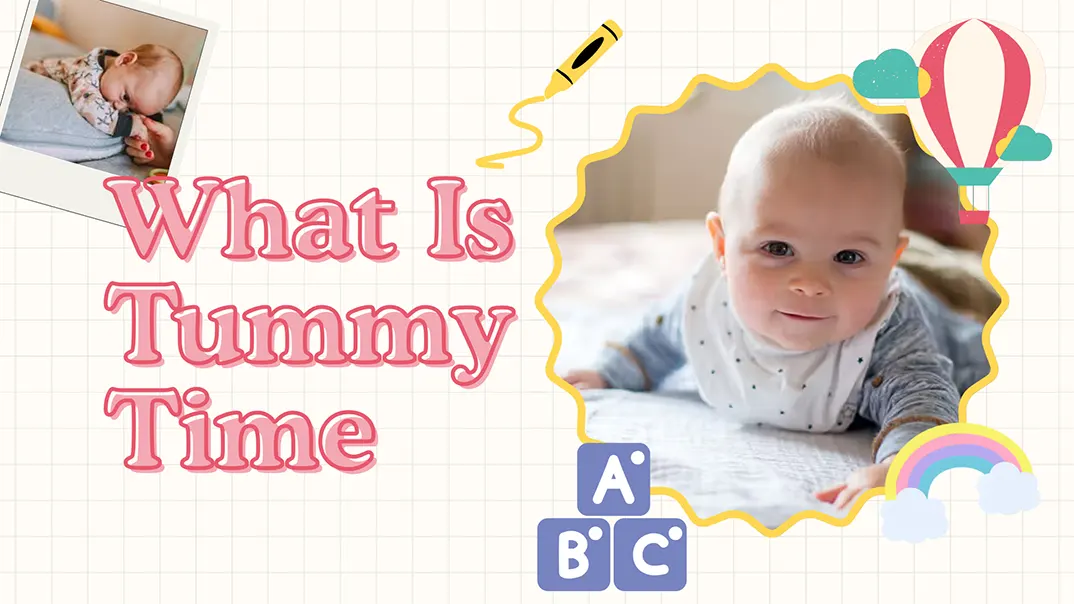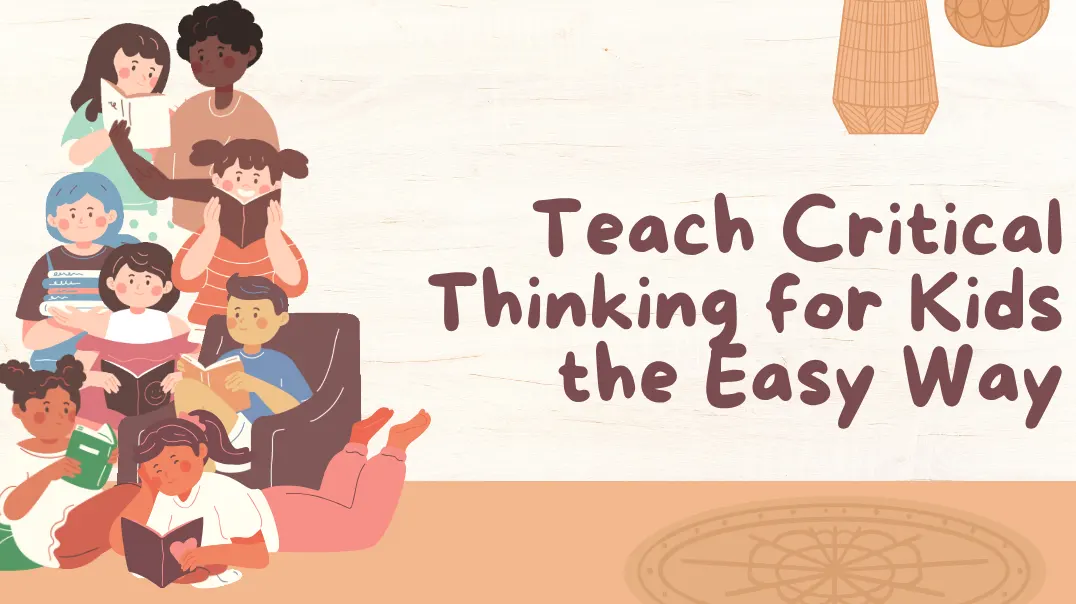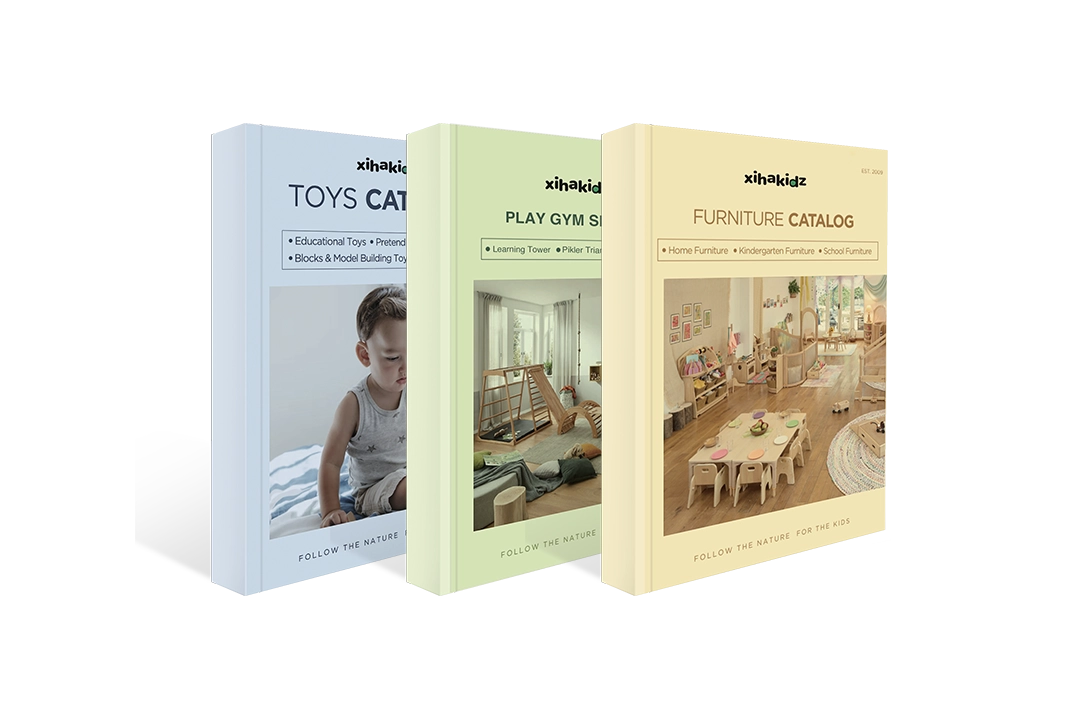¿Te has preguntado alguna vez qué hace que un centro de arte preescolar sea verdaderamente inspirador? ¿Cómo diseñar un espacio que fomente la creatividad y anime a los niños a sumergirse plenamente en el mundo del arte? ¿Qué elementos hacen que un centro de arte preescolar destaque y despierte la pasión de los niños por la autoexpresión?
Un centro de arte preescolar sirve como centro para la creatividad y el desarrollo temprano. Es donde los niños experimentan con colores, texturas y formas mientras desarrollan habilidades cruciales como la resolución de problemas, la colaboración y la autoexpresión. Con el diseño adecuado, este espacio puede ser vital para su crecimiento, despertando un interés artístico permanente y nutriendo su creatividad.
En este artículo, exploraremos cómo crear un centro de arte preescolar que despierte la imaginación de los niños y los anime a descubrir el placer de crear arte. Desde la distribución del aula hasta la elección de los materiales, cada aspecto crea un espacio donde prospera el interés artístico.
Por qué es crucial un centro de arte en preescolar
El centro de arte preescolar ofrece un entorno seguro y acogedor donde los niños pueden expresarse libremente a través de diversos medios, como la pintura, la arcilla y la tela. Mediante esta exploración, los niños desarrollan habilidades fundamentales que les ayudarán en su vida académica y personal.
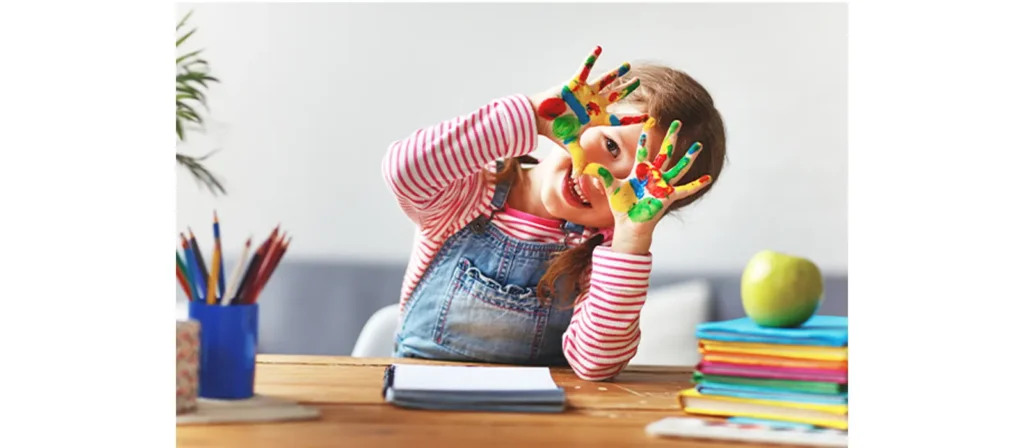
Creatividad y pensamiento crítico
El arte anima a los niños a pensar de forma innovadora. Aprenden sobre arte experimentando con colores, texturas y formas, y desarrollan habilidades esenciales para la resolución de problemas. ¿Cómo se crea un rojo perfecto? ¿Qué sucede al mezclar azul y amarillo? Estas sencillas preguntas incitan a los niños a pensar de forma crítica y lógica, habilidades que se pueden transferir a todas las demás áreas del aprendizaje.
Habilidades motoras finas y coordinación mano-ojo
Los niños que participan en actividades como dibujar, recortar y pegar en un centro de arte de kínder fortalecen sus habilidades motoras finas, cruciales para escribir y manipular objetos en el futuro. Sostener un pincel, tijeras o pegamento en barra les ayuda a perfeccionar su coordinación ojo-mano, sentando las bases para el desarrollo físico y cognitivo. Estas experiencias prácticas fomentan la creatividad y refuerzan habilidades esenciales que los niños seguirán desarrollando a medida que crecen.
Expresión y regulación emocional
El arte ofrece a los niños una poderosa vía para expresar sus emociones. En un mundo donde los niños pequeños a menudo tienen dificultades para expresar sus sentimientos, dibujar, pintar o esculpir puede ofrecerles una forma de comunicar emociones complejas. Esta forma de autoexpresión puede ser particularmente terapéutica, ayudándolos a gestionar y comprender sus sentimientos. A medida que se desarrollan, aprenden a procesar y regular sus emociones a través del arte, una habilidad crucial para la inteligencia emocional.
Planificación de zonas: un espacio para cada actividad creativa
Para maximizar la funcionalidad del centro de arte, divida el espacio en zonas de actividad específicas. Cada zona debe adaptarse a un tipo diferente de actividad creativa, permitiendo a los niños moverse libremente entre ellas.
1. Área de dibujo y pintura
- Equipe esta área con caballetes, rollos grandes de papel, marcadores lavables, crayones y pinturas.
- Proporcionar taburetes o sillas de tamaño infantil para mayor comodidad.
- Utilice superficies de mesa y materiales de piso impermeables y resistentes a las manchas para facilitar la limpieza.


2. Área de Artesanía y Manualidades
- Prepare mesas para realizar actividades como cortar, pegar y crear collages.
- Incluya materiales de manualidades como tijeras (con puntas redondeadas), barras de pegamento, limpiapipas, cuentas y retazos de tela.
- Los contenedores de almacenamiento deben estar claramente etiquetados y al alcance, promoviendo la organización y la independencia.
3. Zona de arcilla y escultura
- Esta área táctil debe incluir arcilla para modelar, plastilina y herramientas para esculpir seguras.
- Proporciona tapetes o bandejas seguros para niños para contener el desorden y proteger las superficies.
- Asegúrese de tener acceso a un fregadero o fuente de agua cercano para lavarse las manos y limpiarse fácilmente.


4. Muro de exhibición e inspiración
- Dedica una sección de la pared a exhibir las obras de arte de los niños. Esto no solo aumenta su confianza, sino que también inspira a otros.
- Incluya carteles, fotografías o elementos visuales de artistas o obras de arte famosos de todo el mundo para generar nuevas ideas.
Consejos para su centro de arte preescolar
Crear un centro de arte preescolar que fomente la creatividad implica mucho más que simplemente proporcionar materiales. Aquí tienes algunos consejos clave para que el espacio sea inspirador y funcional:
- Utilice materiales aptos para niñosElija pinturas, marcadores y herramientas seguros y no tóxicos que sean fáciles de manejar para las manos de los niños. Incluya diversas texturas, como tela o arcilla, para fomentar la exploración sensorial.
- Organízate con almacenamiento accesibleLos contenedores transparentes y los cajones etiquetados ayudan a los niños a encontrar y devolver los materiales fácilmente. Esto no solo mantiene el orden, sino que también fomenta la independencia.
- Incorporar luz natural:Si es posible, seleccione un espacio con mucha luz natural para crear un ambiente luminoso y acogedor que estimule la creatividad.
- Crear áreas de visualización:Reserve un espacio para exhibir las obras de arte de los niños, reforzando sus esfuerzos y aumentando su confianza.
- Rotar materialesMantenga el centro de arte actualizado rotando materiales y actividades. Esto mantiene a los niños interesados y entusiasmados por descubrir nuevas oportunidades creativas.
Guía paso a paso para construir su centro de arte preescolar
Crear un centro de arte preescolar funcional, inspirador y seguro requiere una planificación y reflexión meticulosas. Siga estos pasos para diseñar un espacio donde los niños puedan dar rienda suelta a su creatividad mientras desarrollan habilidades esenciales.
Paso 1: Determinar el tamaño y la ubicación del centro de arte
El primer paso para construir un centro de arte preescolar es seleccionar el espacio ideal. Considere los siguientes factores:

- Tamaño de la habitaciónElija un espacio que pueda acomodar cómodamente a varios niños, permitiéndoles moverse con libertad sin sentirse apretados. Si bien se pueden usar habitaciones pequeñas, los espacios más grandes ofrecen mayor flexibilidad para organizar las estaciones de arte.
- Proximidad a otras zonas:Asegúrese de que el rincón de arte preescolar sea de fácil acceso, pero idealmente no esté al lado de áreas que requieran actividades tranquilas (como zonas de lectura o de siesta) para reducir las distracciones.
- Luz naturalElija una habitación con abundante luz natural para crear un ambiente luminoso y acogedor. La luz natural no solo energiza, sino que también ayuda a los niños a concentrarse en sus tareas.
- VentilaciónLos materiales de arte, como la pintura y la arcilla, pueden generar olores fuertes. Asegúrese de que el espacio tenga una ventilación adecuada para garantizar un ambiente saludable y agradable para los niños.
Paso 2: Diseño y distribución de un centro de arte preescolar
Una vez seleccionado el espacio, es hora de planificar. Disposición del centro de arte preescolarLa disposición debe promover un movimiento fácil y un flujo fluido de actividades:

- Estaciones para diferentes actividadesDivida la habitación en áreas distintas, cada una dedicada a una forma de arte específica: pintura, dibujo, escultura y manualidades. Esto ayuda a los niños a elegir lo que les apetece hacer y a mantener las actividades organizadas.
- Alturas aptas para niñosMantenga los muebles y materiales al alcance de los niños. Los estantes, mesas y caballetes deben estar a su altura para fomentar su independencia.
- Superficies de trabajoProporcione mesas y caballetes resistentes donde los niños puedan participar cómodamente en actividades artísticas. Estos deben ser lo suficientemente amplios como para acomodar sus materiales y permitirles moverse con libertad.
- Diseño que facilita el movimientoAsegúrese de que haya suficiente espacio para que los niños se muevan libremente mientras trabajan e interactúan. Esto puede incluir dejar áreas abiertas para actividades en el suelo, como pintar con pinceles grandes o crear collages.
Paso 3: Elige los muebles preescolares adecuados
Los muebles son cruciales para garantizar que los niños puedan concentrarse en su arte y desarrollar habilidades motoras finas. Cuando seleccionar muebles, considerar:
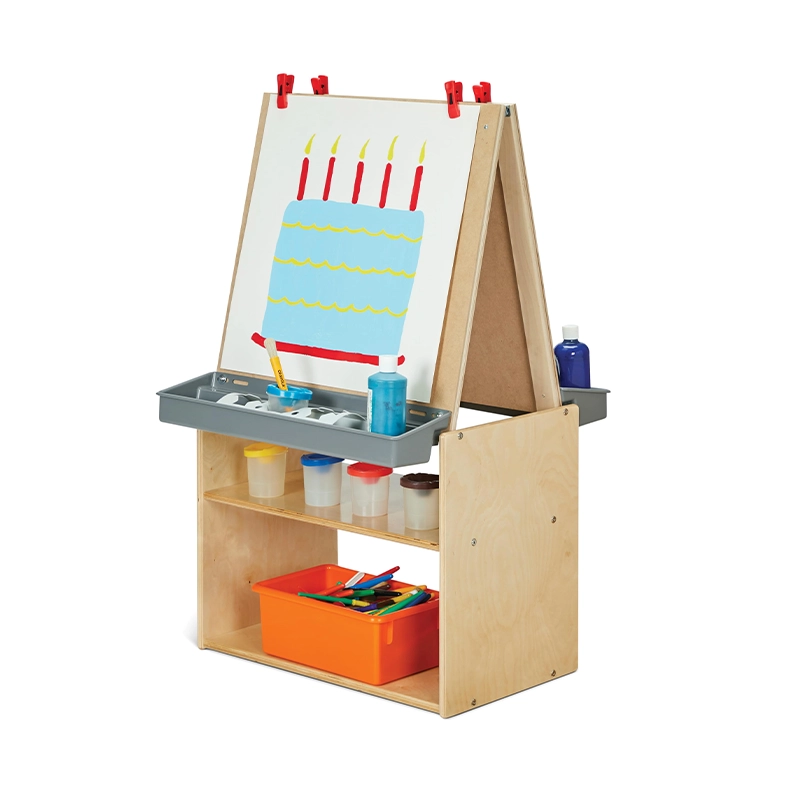

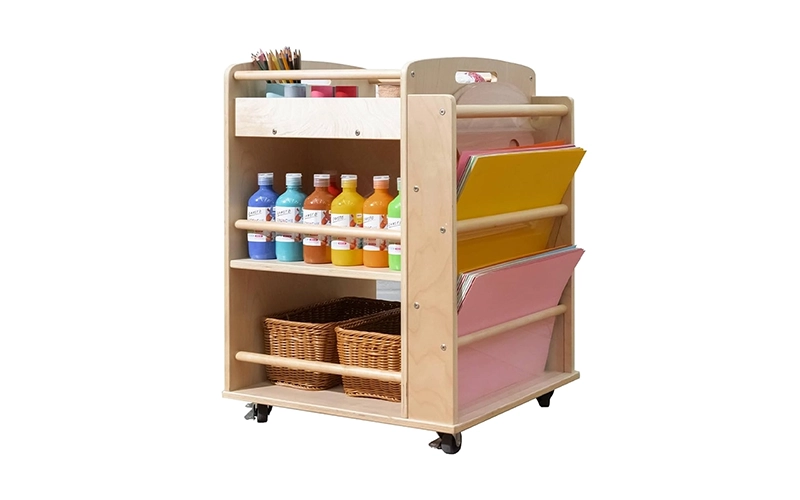
- Mesas y sillas:Opte por productos ligeros y fáciles de mover. mesas y sillas Que se puedan reorganizar para diferentes actividades grupales. Las sillas deben tener el tamaño adecuado para niños en edad preescolar y bordes redondeados para mayor seguridad.
- Unidades de almacenamientoUtilice estanterías bajas accesibles para los niños. Estas permiten acceder fácilmente a los materiales de arte; los niños pueden coger y devolver los artículos por sí solos cuando los necesiten.
- Caballetes:Disponemos de caballetes regulables para que niños de distintas alturas puedan utilizarlos cómodamente para pintar o dibujar.
- Áreas de asientos suaves:Considere agregar un pequeño rincón con cojines suaves o tapetes donde los niños puedan sentarse y explorar el arte en un ambiente relajado y cómodo.
Paso 4: Pisos fáciles de limpiar
Los centros de arte preescolares pueden ser un desastre, por lo que es importante elegir pisos duraderos y fáciles de limpiar. Aquí hay algunas consideraciones sobre pisos:

- Superficies impermeables y lavables:Elija materiales impermeables como vinilo, caucho o laminado que se puedan limpiar fácilmente después de las actividades artísticas.
- Materiales duraderosConsidere pisos resistentes a derrames de pintura, arcilla y otros materiales de arte. La alfombra puede ser menos adecuada, ya que absorbe las manchas y puede ser más difícil de limpiar.
- Consideraciones de seguridadAsegúrese de que el suelo sea antideslizante para evitar accidentes. Un suelo blando o una alfombra acolchada también pueden proteger a los niños en caso de caídas o choques.
Paso 5: Soluciones de almacenamiento de arte
Un centro de arte preescolar bien organizado facilita que los maestros administren los materiales y enseña a los niños el valor del orden y la responsabilidad.
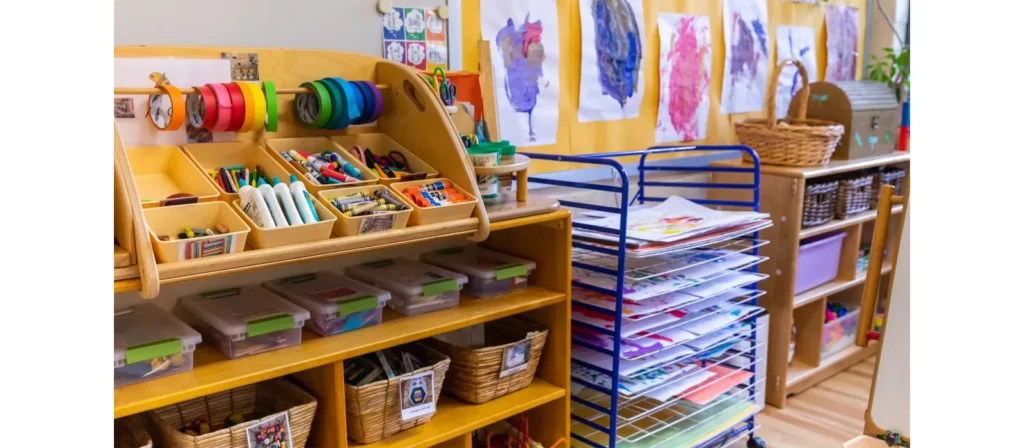
1. Opciones de almacenamiento accesibles
- Utilice estanterías abiertas con contenedores claramente etiquetados para que a los niños les resulte más fácil encontrar y devolver los materiales.
- Lugar unidades de almacenamiento A una altura adecuada para los niños para fomentar la independencia.
- Incluya recipientes transparentes para artículos como cuentas, botones y papel de colores para que los niños puedan ver fácilmente lo que hay disponible.
2. Ideas creativas de almacenamiento
- Los carros rodantes almacenan artículos de uso frecuente, lo que facilita el traslado de suministros entre zonas.
- Instale tableros perforados en la pared para colgar cepillos, tijeras o herramientas, manteniendo las superficies ordenadas.
- Agregue ganchos o pinzas para ropa para colgar obras de arte que se estén secando, creando una solución de secado simple pero funcional.
Paso 6: Usar colores para mejorar la creatividad
El color es una herramienta sutil pero poderosa en el diseño de un centro de arte. Los colores influyen en el estado de ánimo, la concentración y el comportamiento general de los niños.

1. Psicología del color en el diseño
- Los colores brillantes y vibrantes como el rojo, el naranja y el amarillo pueden evocar entusiasmo y energía, lo cual es excelente para estimular la creatividad.
- Los colores fríos como el azul y el verde pueden equilibrar esta energía, proporcionando una atmósfera tranquila que fomenta la concentración.
- Evite combinaciones de colores demasiado brillantes o caóticas, ya que pueden sobreestimular a los niños y hacer que el espacio se sienta desordenado.
2. Decoración y diseño de paredes bien pensados
- Pinta las paredes en tonos neutros y vibrantes para crear equilibrio. Por ejemplo, usa tonos neutros para zonas más grandes y añade toques de color con murales, calcomanías o dibujos infantiles.
- Incorpore elementos educativos a la decoración, como formas, patrones o ruedas de color, para enseñar sutilmente a los niños mientras crean.
Paso 7: Elija una variedad de materiales y herramientas de arte


Al seleccionar materiales de arte Los materiales y herramientas para un centro de arte preescolar se centran en la diversidad, la seguridad y el valor para el desarrollo. Elija artículos que faciliten diversas experiencias sensoriales, como materiales con diferentes texturas, colores y formas, para estimular la creatividad y la exploración. Priorice opciones no tóxicas, apropiadas para la edad, que favorezcan el desarrollo de la motricidad fina y sean fáciles de manejar para los niños pequeños. Considere herramientas que fomenten el juego libre y la adaptabilidad, permitiendo que los niños usen libremente su imaginación. Por último, los materiales deben estar alineados con los objetivos educativos del centro de arte, fomentando tanto la expresión individual como la creatividad colaborativa.
Transforme su aula con soluciones de mobiliario a medida
Centro de Arte Preescolar Materiales
Crear un centro de arte infantil bien equipado requiere seleccionar los materiales adecuados que sean atractivos y seguros para los niños en edad preescolar. Aquí tienes una lista completa de... materiales imprescindibles Para abastecer su centro de arte preescolar:
Materiales básicos de arte:
- Crayones y marcadores:Opte por crayones y marcadores lavables, no tóxicos y de varios colores para permitir que los niños exploren su creatividad.
- Lápices de colores:Proporcione lápices de colores para realizar dibujos más detallados y precisos.
- AcuarelasLas acuarelas no tóxicas son ideales para los niños pequeños y ofrecen una forma divertida de explorar la mezcla de colores.
- Pegamento y barras de pegamento:Estos son esenciales para diversos proyectos como collages y arte 3D.
- TijerasLas tijeras de seguridad diseñadas para niños en edad preescolar son cruciales para cortar papel y desarrollar habilidades motoras finas.
Papel y lienzo:
- Papel de construcción:Ofrecemos una variedad de papeles de colores para diferentes proyectos como cortar, pegar y hacer collages.
- Papel de acuarela:Utilice papel más grueso para pinturas a base de agua para evitar que se deformen o se rompan.
- Papel de dibujo:Papel blanco normal de stock para dibujar y bocetar libremente.
- Paneles de lona:Los pequeños lienzos para proyectos de pintura permiten a los niños experimentar un proyecto de arte “profesional”.
Materiales 3D:
- Arcilla y plastilina:Ideal para esculpir, moldear y desarrollar habilidades motoras finas.
- Materiales naturales:Incluya hojas, palos, piedras y piñas para proyectos de arte basados en la naturaleza.
- Materiales texturizados:Se pueden utilizar telas, láminas de espuma y fieltro para hacer collages o realizar actividades sensoriales.
Herramientas y accesorios de arte:
- Pinceles:Distintos tamaños de pinceles para acuarelas, témperas o incluso esponjas.
- Esponjas y sellos:Estas herramientas son ideales para crear texturas y patrones en proyectos de arte.
- Rodillos de amasar:Úsalos para aplanar arcilla, masa o incluso impresiones texturizadas.
- Reglas y plantillas:Presente a los niños formas, líneas y patrones básicos con estas divertidas herramientas.
Almacenamiento y organización:
- Contenedores de almacenamiento:Los contenedores o cajones transparentes ayudan a mantener los suministros accesibles y organizados.
- Tazas y bandejas:Para guardar pinceles, marcadores y otros objetos pequeños, los vasos o bandejas mantienen los materiales ordenados.
- Batas o delantales de arte:Limpie la ropa de los niños con batas de arte coloridas que se pueden usar durante actividades que ensucian.
Transforme su aula con soluciones de mobiliario a medida
Actividades artísticas para niños en edad preescolar
Las actividades artísticas preescolares deben ser divertidas y estimular el desarrollo cognitivo, motor y emocional. Aquí tienes algunas ideas interesantes para tu centro de arte preescolar:
1. Pintura con los dedos:
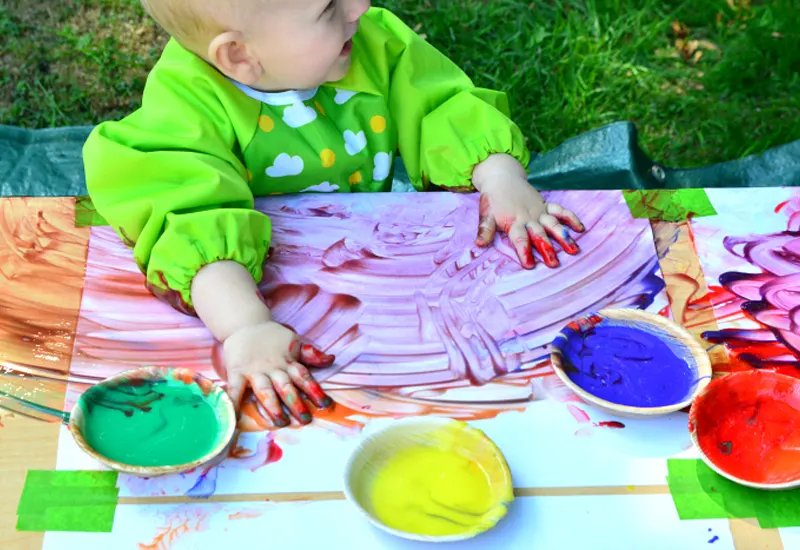
Pintar con los dedos es una actividad táctil y divertida que permite a los niños experimentar con la textura, la mezcla de colores y la creatividad. Pueden experimentar libremente con colores y pinceladas usando pinturas lavables y hojas grandes de papel, lo que les ayuda a desarrollar la motricidad fina y a explorar texturas sensoriales.
2. Collages de la naturaleza:
Salgan y recolecten materiales naturales como hojas, flores o semillas, y luego tráiganlos al centro de arte para crear collages. Esta actividad ayuda a los niños a conectar con la naturaleza mientras desarrollan la motricidad fina al recortar y pegar.

3. Manualidades con platos de papel:
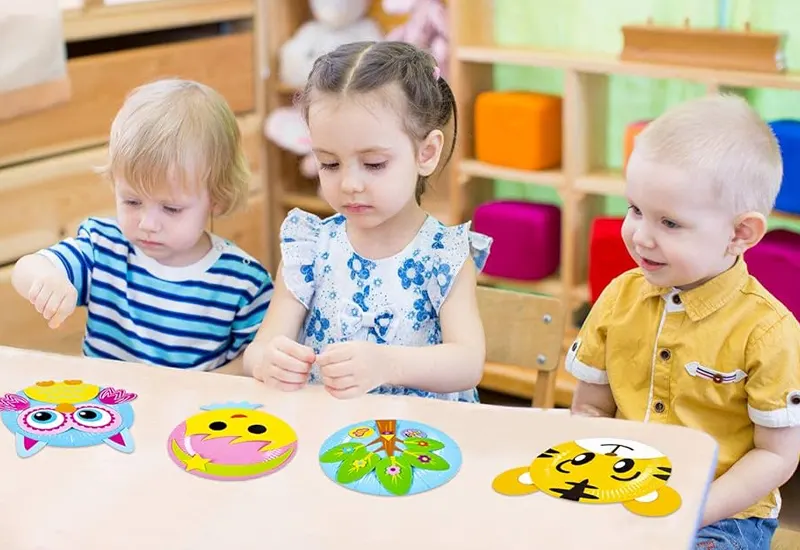
Los platos de papel son un material versátil para crear máscaras, animales o esculturas. Los niños practican recortando, pegando y pintando, desarrollando la motricidad fina y estimulando la creatividad. Con infinitas posibilidades, esta sencilla manualidad puede transformarse en imaginativas obras de arte que estimulan la creatividad infantil.
4. Escultura en arcilla:
La escultura con arcilla de secado al aire o plastilina permite a los niños crear obras de arte tridimensionales, mejorando su coordinación ojo-mano y su motricidad fina. Pueden modelar animales, figuras o formas abstractas mientras aprenden sobre textura y forma.

5. Grabado:
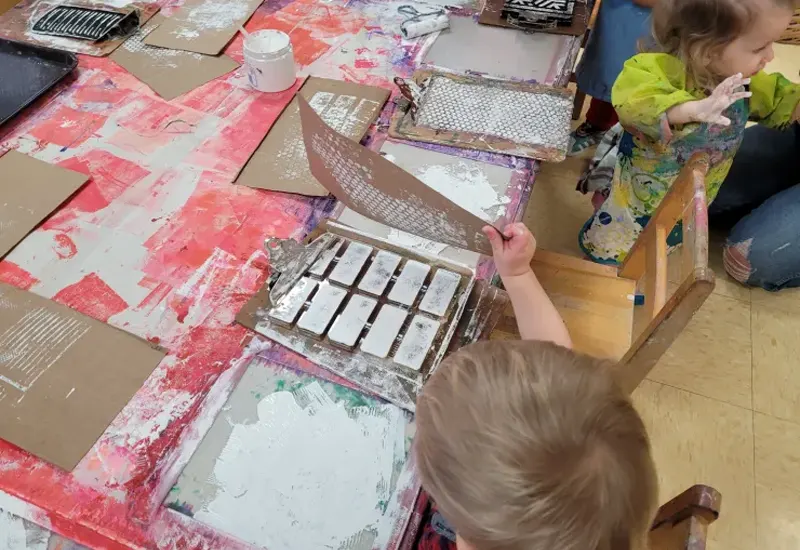
Usando esponjas, sellos u hojas, el grabado permite a los niños explorar texturas, patrones y formas. Esta actividad fomenta la creatividad mediante la repetición y la experimentación con el color, a la vez que les ayuda a comprender las técnicas básicas del grabado y los conceptos de diseño visual.
6. Arte de collage:
Los niños pueden crear collages vibrantes pegando diversos materiales como botones, cuentas y papeles texturizados sobre un fondo. Esta actividad fomenta la creatividad, el reconocimiento de colores y la motricidad fina, ya que exploran las capas y las texturas al crear diseños artísticos.
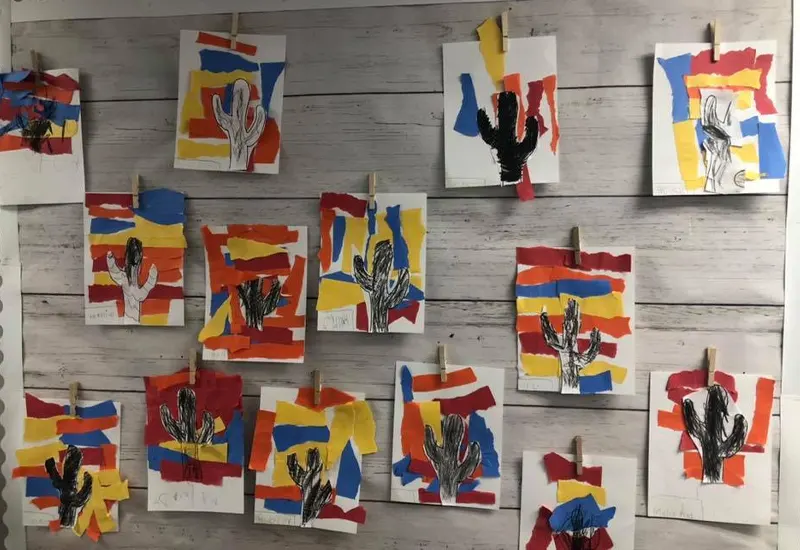
Reglas del Centro de Arte Preescolar
Establecer reglas claras y sencillas en el centro de arte ayudará a los niños a comprender cómo usar el espacio y los materiales con respeto. Aquí hay algunas reglas fundamentales a considerar:
1. Utilice los materiales de forma ordenada y respetuosa
Anime a los niños a usar los materiales de arte de forma que duren más. Cuando terminen, enséñeles cómo guardar correctamente artículos como crayones, pinceles y barras de pegamento.
2. Compartir materiales
Dado que el centro de arte puede tener varios niños usándolo simultáneamente, fomente el uso compartido. Esto fomenta la cooperación y la paciencia. Establezca sistemas claros para organizar los materiales y así reducir cualquier conflicto.
3. Limpia después de ti
Incorpore la limpieza al proceso artístico. Enséñeles a limpiar los pinceles, devolver los objetos a sus lugares designados y desechar los restos de forma adecuada. Esto les inculca responsabilidad y un sentido de pertenencia.
4. Respeta las obras de arte de los demás
Enseñe a los niños a apreciar y respetar el trabajo creativo de los demás. Anímelos a felicitarse o a hablar sobre lo que les gusta del arte de los demás, fomentando así un ambiente positivo.
5. Siga las pautas de seguridad
Asegúrese de que los niños utilicen tijeras, pegamento y otras herramientas de forma segura. Supervise siempre a los niños mientras las utilizan para evitar accidentes.
Mantener el Centro de Arte para un Compromiso a Largo Plazo
El mantenimiento regular y una planificación minuciosa son necesarios para que el centro de arte preescolar siga siendo atractivo a lo largo del tiempo. Aquí tienes algunos consejos para mantener el interés y el orden en el área de arte preescolar:
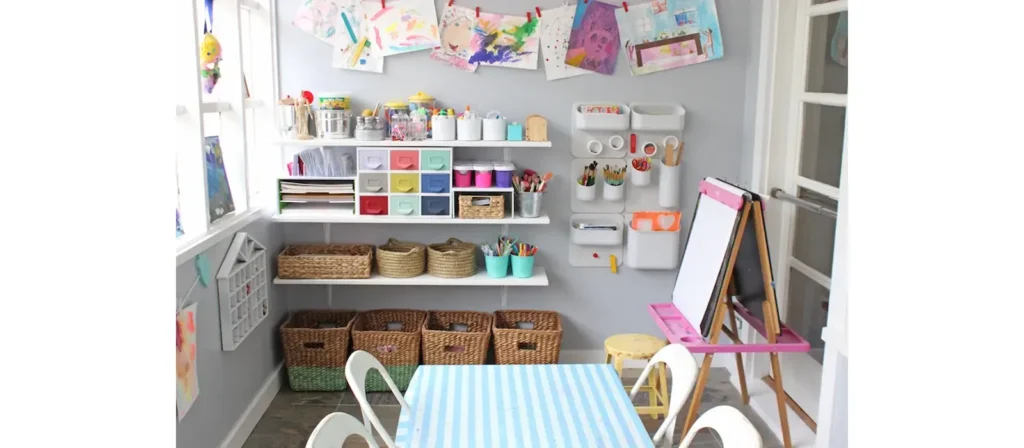
Rotar regularmente los materiales de arte
Cambie los materiales o temas del centro de arte preescolar cada pocas semanas. Esto mantiene el espacio fresco y emocionante. Puede cambiar los artículos de temporada o introducir nuevas herramientas y medios para fomentar diferentes tipos de creatividad.
Mantener la limpieza
Asegúrese de que todos los materiales se limpien y desinfecten regularmente, especialmente herramientas como pinceles y marcadores. Limpie las superficies y los pisos para mantener un espacio higiénico. Establezca un horario de limpieza regular con el personal o anime a los niños a colaborar con tareas sencillas de limpieza.
Fomentar la creatividad continua
Cree oportunidades para que los niños exploren nuevas técnicas y estilos. Ofrezca actividades diversas que los estimulen, pero que también les permitan experimentar con su expresión artística.
Mostrar y rotar obras de arte
Cree un área en el aula donde se puedan exhibir las obras de arte de los niños. Cambiar las obras expuestas con regularidad motivará a los niños a seguir creando. Podría organizar una inauguración de obras de arte donde los niños muestren sus obras a sus padres y compañeros.
Mantenga los materiales accesibles y organizados
Un centro de arte organizado es esencial para una participación a largo plazo. Ordene y reponga los materiales con regularidad y asegúrese de que todo sea fácilmente accesible para los niños. Invierta en opciones de almacenamiento duraderas que mantengan los materiales en excelentes condiciones.
Conclusión
El centro de arte preescolar es más que un simple espacio de juego: es una parte vital de la educación infantil temprana que sienta las bases para la creatividad, la resolución de problemas y el crecimiento emocional. Ofrecer materiales diversos, actividades atractivas y pautas claras crea un espacio donde los niños pueden explorar su imaginación y desarrollar habilidades valiosas. Con el tiempo, este entorno fomenta la independencia, la confianza y la alegría en la expresión artística.
Los niños experimentan con diferentes herramientas y técnicas para crear obras de arte y establecer conexiones cognitivas, sociales y emocionales esenciales. El centro de arte sirve como punto de partida para sus experiencias de aprendizaje más amplias, animándolos a pensar críticamente, colaborar con sus compañeros y expresar sus ideas. De esta manera, su centro de arte preescolar se convierte en algo más que un simple elemento del aula: un entorno enriquecedor que despierta la curiosidad y la pasión por el aprendizaje para toda la vida.
Descubra toda nuestra gama de productos
Acceda a nuestro completo catálogo de mobiliario y equipos de juego de alta calidad para guarderías y escuelas.

